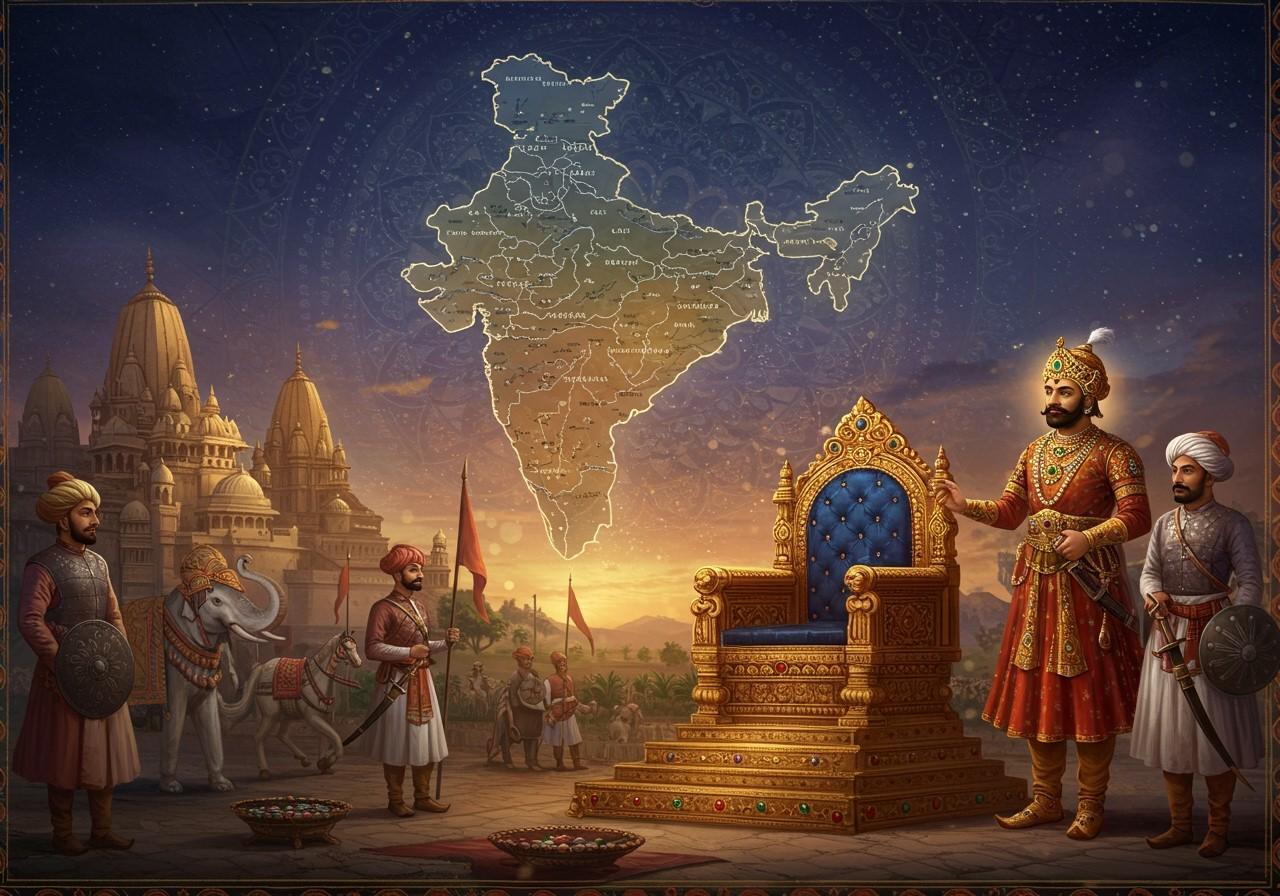
The Gurjara-Pratihara Empire, renowned for its formidable military strength, played a pivotal role in shaping medieval Indian history. Their reign, spanning from the 8th to the 11th century CE, significantly influenced Indian culture and encompassed vast territories across western and northern India, even extending into parts of the east and central regions through conquests. Understanding their dominion allows us to appreciate their invaluable contributions to India’s rich heritage.
Historical Background
The Gurjara-Pratihara dynasty, also known as the Pratiharas of Kannauj or the Imperial Pratiharas, emerged with Nagabhata I in the 8th century CE. The empire reached its zenith under the reign of Mihira Bhoja. Crucially, the empire acted as a bulwark against Arab invasions, ensuring stability and preserving the cultural fabric of India. Key rulers not only expanded the empire’s territorial reach but also fostered the flourishing of art and architecture.
Geographic Extent
The Gurjara-Pratihara Empire held sway over extensive regions of western and northern India, including parts of present-day Rajasthan, Gujarat, Madhya Pradesh, Uttar Pradesh, and Haryana. Kannauj, their capital, served as a major political and cultural hub. These strategically important regions played a vital role in trade and defense, contributing to the empire’s prosperity and power.
Empire Map
The empire’s boundaries were dynamic, constantly shifting due to ongoing wars and strategic alliances. Battles with contemporary powers like the Rashtrakutas and Palas resulted in territorial gains and losses. These fluctuating borders played a crucial role in shaping interactions and power dynamics with neighboring kingdoms.
Cultural and Political Influence
The Gurjara-Pratihara Empire left an indelible mark on Indian art, architecture, and literature. They commissioned the construction of magnificent temples and palaces, showcasing their architectural prowess. Their effective governance model ensured stability and prosperity within the empire. Furthermore, they actively promoted Hinduism and staunchly resisted foreign incursions, playing a crucial role in preserving India’s cultural heritage.
Legacy and Historical Significance
The Gurjara-Pratiharas left a lasting legacy, most notably through their valiant resistance against Arab invasions, which significantly shaped India’s cultural landscape. The architectural marvels from their reign stand as enduring testaments to their artistic and engineering skills, serving as important heritage sites today. Their influence can be seen in the political and cultural structures of later empires.
Modern Relevance
The history of the Gurjara-Pratihara Empire holds immense relevance for contemporary Indians, fostering a sense of cultural pride and identity. Historians and archaeologists continue to work diligently to preserve and study Pratihara sites, unraveling the intricacies of this era. Learning about this empire is essential for a comprehensive understanding of India’s rich and complex history.
Connecting with Gurjara-Pratihara Traditions Through Poojn.in
The vast territory of the Gurjara-Pratihara Empire across northern India fostered unique ritual practices that continue to resonate even today. Poojn.in plays a vital role in preserving these sacred traditions by offering authentic products essential for traditional pujas reminiscent of the Pratihara period. Our offerings help individuals connect with their heritage and maintain the spiritual practices of their ancestors.
-
Clay Ritual Items: Our Medium Size Ghot (Clay Noggin) and other clay items are crafted following ancient specifications, similar to vessels used in temples across the Pratihara realm. These are perfect for traditional water rituals and abhishekam ceremonies, still prevalent in regions once under the empire’s rule. These items allow for a tangible connection to the past, enriching modern spiritual practices.
-
Authenticity and Quality: We offer larger clay ghats and other ritual items reflecting the sophisticated worship practices of the Pratihara period. Each product is carefully selected for authenticity and quality, ensuring it meets traditional standards and is suitable for sacred use. This commitment to quality guarantees a genuine and meaningful experience for those seeking to connect with their heritage.
-
Convenient Access: All ritual items are available for direct home delivery across India, making it easier to maintain authentic practices regardless of location. This accessibility empowers individuals to engage with their traditions and incorporate them into their daily lives, regardless of geographical constraints. Explore our complete range of clay ritual items and other puja essentials at Poojn.in.
Conclusion
The Gurjara-Pratihara Empire stands as a powerful testament to India’s rich heritage, resilience, and cultural vibrancy. Their vast territorial control, significant cultural contributions, and formidable military prowess indelibly shaped the course of medieval Indian history. By learning about their extent and influence, we honor the legacy of a powerful empire that diligently preserved and promoted Indian traditions. As we appreciate their historical significance, we forge a deeper connection with our roots and gain a more profound understanding of India’s vibrant past.
FAQs About the Gurjara-Pratihara Empire
What was the Gurjara-Pratihara Empire’s geographical reach? The Gurjara-Pratihara Empire held dominion over large swathes of northern India, encompassing regions within present-day Rajasthan, Gujarat, Uttar Pradesh, Madhya Pradesh, and Haryana. Their influence extended through both direct rule and tributary relationships with neighboring kingdoms.
What key regions did the Gurjara-Pratiharas control? The Gurjara-Pratiharas exerted control over crucial regions in northern India, notably Rajasthan, Gujarat, Uttar Pradesh, Madhya Pradesh, and Haryana. Kannauj, their capital, held immense strategic and cultural importance.
Did the Gurjara-Pratihara Empire wield substantial influence in India? Yes, the Gurjara-Pratihara Empire exerted considerable influence across northern India. Their role in repelling Arab invasions and fostering cultural and artistic development significantly shaped the region’s trajectory.
What was the capital of the Gurjara-Pratihara Empire? Kannauj served as the capital of the Gurjara-Pratihara Empire, functioning as a vital center of political power, trade, and cultural exchange.
What was the duration of the Gurjara-Pratihara Empire? The Gurjara-Pratihara Empire flourished from the 8th century CE to the 11th century CE, marking a significant period in medieval Indian history.
What is the historical significance of the Gurjara-Pratihara Empire? The Gurjara-Pratihara Empire holds a prominent place in Indian history due to their instrumental role in thwarting Arab advances, thereby safeguarding India’s cultural heritage. They also made substantial contributions to the political and cultural landscape of northern India.


